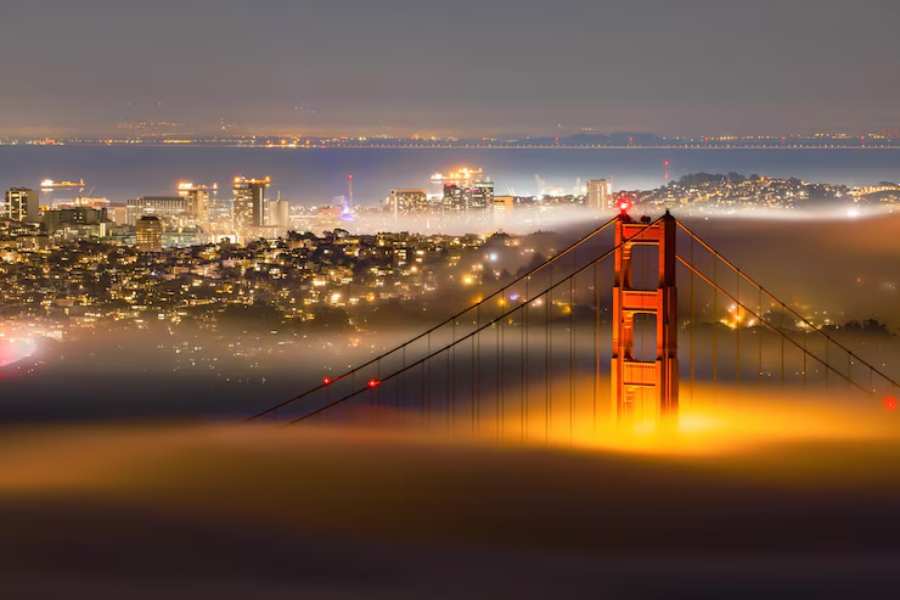
Get ready for one of the most interesting moves of your life! San Francisco is about to teach you things about resourcefulness, creativity, and finding joy in small spaces that you never knew you needed to learn. You’re heading to a city where innovation isn’t just about tech startups, it’s about figuring out how to live well when your entire apartment costs more than most people’s mortgage.
San Francisco welcomes small moves with open arms because honestly, most apartments here require them. The city’s housing situation has created a culture where people have mastered the art of living beautifully in spaces that would challenge a minimalist monk. You’re joining a community of problem-solvers who’ve turned tiny living into an art form.
You’re moving to a place where your neighbors might be working on the next big app while brewing their own kombucha and growing herbs on fire escapes. The energy here is infectious, and the creative solutions people come up with for space challenges will inspire your own approach to city living.
The good news about planning a small move to San Francisco is that you’re entering a city where being strategic about possessions isn’t just practical, it’s culturally celebrated. When rent costs what it costs here, every item in your space needs to earn its place through beauty, function, or both.
Why This Moving Strategy Works Perfectly Here
Trust me, attempting a large move in San Francisco is like trying to navigate a maze while blindfolded. The city’s layout, parking situation, and building restrictions make small moves not just preferable but actually the smart choice for maintaining your sanity and budget.
Most San Francisco apartments were created by dividing larger spaces, which means floor plans that require creative thinking about furniture placement. Your living space might serve multiple functions throughout the day, and that’s perfectly normal here. People have turned this constraint into opportunities for beautiful, multi-purpose design.
The city’s steep hills and narrow streets create logistical challenges that expert moving companies have learned to handle efficiently. They’ve developed specialized techniques for navigating San Francisco’s unique geography, and their experience shows in how smoothly they handle what could otherwise be complicated moves.
San Francisco’s tech-driven population means there’s always high-quality furniture available from people making career transitions, relocating for new opportunities, or simply upgrading their living situations. Your small move can focus on essentials while you discover amazing local finds.
Storage solutions throughout the Bay Area cater to people who live in small spaces but lead full lives. Climate-controlled facilities help bridge the gap between what you want to keep and what you can immediately accommodate in your new space.
The Neighborhood Personality Map
San Francisco’s neighborhoods pack more personality per square block than most entire cities, and choosing where to live becomes a decision about what kind of urban experience you want to create for yourself.
The Mission offers vibrant street art, incredible food, and a community feel that attracts creative professionals who want authentic urban culture without the corporate sanitization that characterizes some other areas. The neighborhood has energy that extends well into the evening.
SOMA puts you in the heart of the tech world with modern amenities, convenient commuting options, and restaurants that cater to people with good salaries and busy schedules. Living here means being close to major companies and the networking opportunities that come with proximity.
Castro combines historic significance with modern community, creating a neighborhood that’s both culturally important and socially active. The area offers strong community connections and a walkable lifestyle with plenty of local businesses and gathering places.
Nob Hill provides classic San Francisco living with cable car access, stunning views, and architecture that reminds you why people fall in love with this city. The area offers urban sophistication with a residential feel that’s increasingly rare in the city.
Richmond and Sunset districts offer more residential atmospheres with diverse communities, parks access, and housing options that provide better value for people who don’t need to be in the downtown core every day.
The Practical Moving Advantages
Most San Francisco apartments were created by dividing larger spaces, which means floor plans that require creative thinking about furniture placement. Your living space might serve multiple functions throughout the day, and that’s perfectly normal here. People have turned this constraint into opportunities for beautiful, multi-purpose design.
The city’s steep hills and narrow streets create logistical challenges that expert moving companies have learned to handle efficiently. They’ve developed specialized techniques for navigating San Francisco’s unique geography, and their experience shows in how smoothly they handle what could otherwise be complicated moves.
San Francisco’s tech-driven population means there’s always high-quality furniture available from people making career transitions, relocating for new opportunities, or simply upgrading their living situations. Your relocation can focus on essentials while you discover amazing local finds.
Storage solutions throughout the Bay Area cater to people who live in small spaces but lead full lives. Climate-controlled facilities help bridge the gap between what you want to keep and what you can immediately accommodate in your new space.
The Innovation Economy Reality
Living in San Francisco means being surrounded by people who are building the future, which creates an atmosphere of possibility and ambition that influences conversations, opportunities, and the overall energy of daily life.
Networking happens naturally here because casual encounters often lead to professional opportunities, collaborative projects, or learning experiences that wouldn’t exist in other cities. Coffee shops become informal coworking spaces where interesting conversations develop organically.
The entrepreneurial culture encourages risk-taking and creative problem-solving that extends beyond work into all aspects of life, including how people approach housing, transportation, and community building in a challenging urban environment.
Co-working spaces throughout the city provide professional infrastructure for freelancers, remote workers, and people building their own companies. These spaces create professional communities that often become social networks as well.
The success stories and learning opportunities here provide inspiration and practical education about building careers, taking calculated risks, and creating value in ways that traditional career paths might not offer.
Transportation That Actually Works
San Francisco’s public transportation system, combined with the city’s walkable neighborhoods and bike-friendly infrastructure, makes car ownership optional rather than necessary, which significantly affects your cost of living and daily experience.
Muni buses and light rail connect neighborhoods efficiently, though learning the system’s patterns and timing helps you navigate the city more effectively. The transportation network provides access to most areas you’ll need for work and social activities.
Walking becomes a primary transportation method for daily activities, and the city’s compact size makes most neighborhoods accessible on foot. The hills provide built-in exercise, and comfortable walking shoes become essential equipment rather than optional accessories.
Bike culture thrives here with dedicated lanes, bike share programs, and a community of cyclists who understand the city’s terrain and traffic patterns. Electric bikes make the hillier routes manageable for more people and extend the practical range of bike commuting.
Ride-sharing services work seamlessly for occasional longer trips or situations where public transit doesn’t provide convenient options. The costs can add up for regular use, but the convenience and reliability are excellent for specific needs.
Weather That Requires Strategy
San Francisco’s microclimates mean you can experience different weather conditions within a few blocks, which requires clothing strategies that adapt to changing conditions rather than consistent weather patterns.
The famous fog creates dramatic cooling effects that make summer evenings feel surprisingly cool, while sunny neighborhoods stay warm throughout the day. Layering becomes essential because conditions change as you move around the city.
Seasonal variations are subtle compared to other cities, but the microclimates between neighborhoods create significant differences in temperature, wind, and sunshine that affect daily comfort and activity planning.
Wind patterns from the bay create conditions that can turn pleasant walks into challenging experiences depending on your route and timing. Understanding which areas stay calmer helps with both housing choices and daily planning.
The moderate climate means you don’t need extensive seasonal wardrobes, but you do need versatile pieces that work across the city’s various weather conditions and social situations.
Food Culture That Justifies Everything
San Francisco’s restaurant scene provides one of the strongest arguments for accepting the city’s high costs because the quality, diversity, and innovation available here exceed what most cities offer at any price point.
Neighborhood food scenes reflect the city’s cultural diversity and economic range, from casual spots that serve incredible food at reasonable prices to high-end restaurants that showcase culinary innovation and local ingredients.
Food truck culture and farmers markets provide access to fresh, local ingredients and prepared foods that often rival expensive restaurants in quality and creativity. These options help balance food costs while maintaining access to excellent eating.
The farm-to-table movement here connects you with Northern California’s agricultural abundance through restaurants and markets that emphasize seasonal, local ingredients. This creates both great eating and education about regional food systems.
Coffee culture goes beyond caffeine into community building, with neighborhood cafes that serve as social hubs, remote work spaces, and gathering places that help create connections in an otherwise expensive and sometimes isolating city.
Outdoor Access Within Urban Living
San Francisco’s proximity to natural beauty and outdoor recreation provides balance to urban intensity and helps justify the trade-offs that come with expensive city living.
Golden Gate Park offers extensive recreational opportunities within the city, from museums and gardens to trails and open spaces where you can escape urban stress without leaving the city limits.
Bay Area hiking and outdoor recreation are accessible via public transportation or short drives, providing weekend adventures and exercise opportunities that help balance intense work schedules and urban living challenges.
Beach access along the Pacific coast creates opportunities for surfing, walking, or simply experiencing natural beauty that reminds you why people choose to live in Northern California despite the costs and challenges.
The region’s outdoor recreation culture provides social opportunities and community connections that don’t depend on expensive entertainment options, creating ways to build relationships and enjoy life without constantly spending money.
Making Small Move Economics Work
SuccesSan Franciscoully managing a small move to San Francisco requires strategic thinking about costs, priorities, and lifestyle choices that help you enjoy the city’s benefits without financial stress that undermines the experience.
Housing budgets need to account for the city’s premium pricing while identifying neighborhoods and living arrangements that provide the best value for your specific needs and lifestyle priorities.
Roommate situations often provide the most realistic path to affordable housing, which means your small move should accommodate shared living arrangements and the coordination that comes with adult roommates.
Income expectations should reflect both the city’s salary ranges and the career advancement opportunities that San Francisco provides through networking, skill development, and exposure to cutting-edge industries.
Cost management strategies help you enjoy the city’s cultural and social offerings without overspending on lifestyle maintenance that doesn’t actually contribute to your happiness or professional development.
The Reality of San Francisco Living
Moving to San Francisco requires honest assessment of your financial situation, career goals, and lifestyle adaptability because the city demands adjustments that aren’t immediately obvious when planning from a distance.
The pace of change here affects everything from neighborhood character to job markets to social scenes, which means flexibility and adaptability become essential skills for long-term satiSan Franciscoaction.
Social connections often develop through shared experiences of navigating the city’s challenges, creating friendships based on mutual problem-solving and creative approaches to urban living.
Professional opportunities here can accelerate career development significantly, but they also require commitment to continuous learning and networking that goes beyond traditional job performance.
The temporary nature of many people’s San Francisco experience means building community quickly and making the most of opportunities while you’re here, whether that’s for two years or twenty.
Your small move to San Francisco isn’t just about relocating, it’s about joining one of the world’s most dynamic cities during an incredible period of innovation and creativity. The challenges are real, but so are the opportunities to grow professionally, personally, and creatively in ways that don’t exist anywhere else. You’re not just moving your stuff, you’re positioning yourself at the center of technological and cultural change that’s shaping the future.





